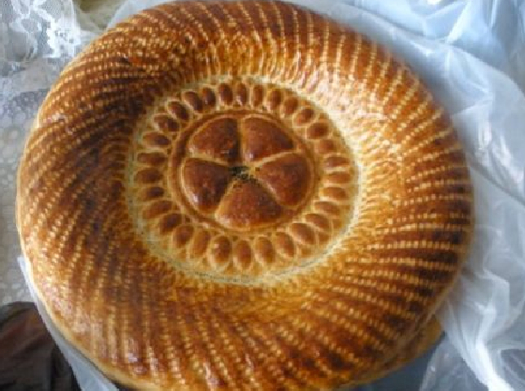The more I learn about flatbreads…

…the more I realize I’m woefully under-utilizing the baking space in my brick oven (it has a perfectly good ceiling!). These breads from Uzbekistan are truly amazing, both in the way they look and they way they’re baked, which is quite similar to naan and lavash. However whereas naan and lavash are adhered to vertical oven walls, these truly defy gravity stuck to the curving ceilings of barrel-style ovens. Check it out — and how about that groovy round-ended rolling pin? Those little decorative stamps they use in the center are pretty hip too. And if you’re wondering how they get that nifty scalloped edge on the sides, it’s a spoon! I tell you, breads don’t normally get me all that excited, but the world of flatbreads is truly amazing. Where can I get an oven mitt that reaches my neck? Thanks to reader Dani for putting me on the trail!
Thanks for sharing Joe and reader Dani! These were so beautiful to watch. There is something about the connection between people and bread that is so special.
Eva
Great video, Joe! This may be very obvious, but do you know why the woman sprinkles the breads with water after taking them out of the oven? I know that having a pan of water *in* the oven produces a crispier crust, but I can’t figure out what effect sprinkling them afterwards would have.
Hey Jen!
It’s not obvious at all…in fact I don’t really know why. She seems to be lightly rubbing it on, which doesn’t make much sense to me unless perhaps she’s washing off ash that may have risen up from the fire below. The only other thing I can think is that it may be sugar water and she’s apply a thin glaze. That’s all I can think!
Thanks for the great question!
– Joe
It is to soften the crust, as the final desirable texture of the bread is for it to be somewhat softer, especially around the edges.
Thanks very much, Dani. That explains it!
– Joe
It’s enough to gat a fella thinking about building a pizza oven in that unused garden area behind the shed…who has the plans for a low-cost, aesthetically pleasing barrel-type wood fired oven? Google it!
Hey Dave!
The one I built is a barrel-style, designed by the late Alan Scott of Ovencrafters. The nice thing about his designs is that they can be implemented using materials you can find at any hardware store. No expensive imported Italian clay oven liners…it’s all fire brick and concrete. Mine went up for about $1,500 total. Here’s where you can order the plans:
http://ovencrafters.net
Have fun and send photos!
– Joe
You might like this Joe…I lived in Kyrgyzstan (adjacent country to Uzbekistan) and we always tore up the leftover naan from the night before and pan fried it for breakfast with eggs. YUM, basically.
Whoa…I’m doing that tomorrow! Thanks, Stephanie!
– Joe
A gorgeous loaf in your photo and a fascinating video at the link.
I see “tandir” in the video’s title and she’s using her oven like a side-lying tandoor. It certainly comes out a lot more attractive than Indian flatbreads tho.
I checked a map to see what the relationship between Uzbekistan and India might be. It’s not terribly far north of Pakistan as global things go but Wikipedia says the language group is related to Persian so I’m still not clear about the influences.
Tanoors (Iran), tandirs (Uzbekistan) and tandoors (northern India) must surely be related. As to how these breads and techniques were spread I don’t know, but it probably happened a very, very long time ago!
– Joe
The little decorative stamp is a chekitch. Alford and Duguid mention them on page 303 of their book “Home Baking”. They note that they were gifted with one made from a bundle of feathers: the quills were sharpened and that end impacted the dough, so the feathers were the handle.
Very cool.
Pictures on the web:
http://www.thekitchn.com/bread-as-canvas-uigher-nan-149793
http://www.readoz.com/publication/read?i=1024025&pg=20#page24
Ah yes! I was wondering what those little prongs were…bird feathers! Makes perfect sense. Thanks very much, Ted!
– Joe
Great videos – thanks so much for sharing -I’ve never seen bread cooked like that before – fascinates me how they stick to the walls 🙂
Amazing what a wet dough can do, isn’t it? I’m amazed myself!
Thanks Heather!
– Joe
The reason she applies water on the back is that it has to stick well to the wall of the Tandoor/ Tandir. If it is not wet, with the heat inside it will immediately fall off. The water on the front side is of course for the glaze and crisp.
Hey Vrushali! I think the question was why it was being applied after the baking, not before. I totally understand what you mean about the rest, however. Makes perfect sense.
– Joe